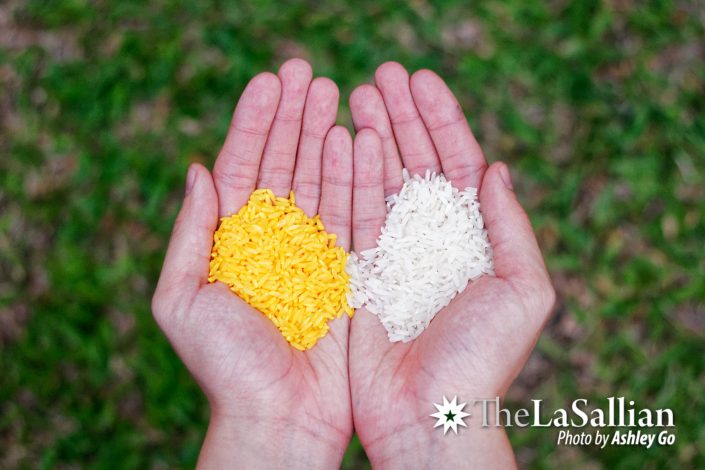Last December 10, the Philippines became the first country in Asia to achieve government approval for Golden Rice. This came after two years of rigorous research and vetting by the Bureau of Plant Industry (BPI) of the Department of Agriculture, as initiated by an application jointly submitted by the International Rice Research Institute (IRRI) and the Philippine Rice Research Institute.
Unlike other varieties of rice, Golden Rice is genetically engineered (GE) to furnish provitamin A in its grains in the form of β-carotene, a type of carotenoid that gives the rice its golden hue. These carotenoids are the same molecules found in carrots, squash, and tomatoes, and are converted into vitamin A by the human body. Among other things, vitamin A is essential for vision, reproduction, and immune function.
Rooted in innovation
The brainchild of professors Ingo Potrykus from the Swiss Federal Institute of Technology in Zurich and Peter Beyer from the University of Freiburg, Golden Rice received initial funding from the Rockefeller Foundation and the Swiss government. It was a response to vitamin A deficiency (VAD), which ravaged Southeast Asia throughout the 1990s.
The professors’ research was anchored in the idea that although rice had the innate ability to produce β-carotene, it was inactivated in the grain. To reactivate this ability, the professors inserted two foreign genes into the DNA of rice—namely, plant phytoene synthase gene from the common daffodil and bacterial phytoene desaturase gene from a soil bacterium. These two genes code for enzymes that facilitate the creation of β-carotene in their respective organisms, and when present in rice, similarly enable the plant to produce β-carotene in its grains.

Against the grain
Following BPI’s approval of Golden Rice, opposition groups such as Magsasaka at Siyentipiko para sa Pag-unlad ng Agrikultura (Masipag) and Greenpeace publicly denounced the bureau’s decision, citing a lack of government supervision and insufficient testing as their gripes.
Greenpeace, historically a critic of genetic engineering, highlighted in their 2013 publication that Golden Rice is an “environmentally irresponsible” innovation, and further that the grain “poses risks to human health, and could compromise food, nutrition, and financial security.” Part of this critique is the nutritional aspect of Golden Rice, which Greenpeace claims “does not address the underlying causes of VAD, which are mainly poverty and lack of access to a healthy and varied diet.”
On the same camp is Masipag, a local farmer-led organization that places great importance on improving “the quality of life of resource-poor farmers.” In an interview with The LaSallian, Masipag National Coordinator Cris Panerio details the reasons for his organization’s opposition to Golden Rice, citing primarily that “from the point of view of Masipag, there is no scientific consensus yet on the safety for human consumption of genetically-modified crops.”
Panerio also muses, “We [at Masipag] view this at a wider perspective; Golden Rice is not about addressing health problems of the people, [but] is about controlling [what] seeds [are available to farmers] and extracting more profits from [agriculturalists].”
An informed response
Despite what Golden Rice’s detractors have aired—and with intensity, to boot—the scientific consensus on GE crops is that they are “considered safe for human and animal consumption, as well as for the environment,” remarks Dr. Peter Magdaraog from the BPI Biotechnology Office in an interview with The LaSallian. “In fact, for more than a decade, the Philippines has already been cultivating genetically modified (GM) crops, as in the case of Bt corn,” he emphasizes, referring to corn that was genetically engineered to produce insecticidal proteins as an anti-pest mechanism.
Magdaraog also dispels claims that GE crops are harmful to native plant life, elaborating that the Department of Environment and Natural Resources (DENR) has conducted an “environmental risk assessment [that] looked into the traits of the introduced crops and analyzed whether changes can lead to potential weediness.” He recalls, “Based on [DENR’s] reports, as long as the GM traits are not integrated or introgressed, the plants will not survive unless taken care of by the farmers.” In simpler terms, GE crops need human supervision to thrive and as such are highly unlikely to weed over or harm native flora.
Much of the ire directed toward Golden Rice is also based on the perception that it attempts to be the sole solution to VAD; Greenpeace has previously claimed that “the single-crop approach of GE Golden Rice could make malnutrition worse because it encourages a diet based solely on rice.” The IRRI, however, clearly states that the grain was intended as “a complementary, food-based solution for vitamin A-deficient communities who consume rice as a staple food,” and not as a be-all-end-all solution or nutritional source.
Balanced scales
What the discourse orbiting Golden Rice demonstrates is that the constant back-and-forth between concerned citizens and experts is essential in building public trust in institutions of Science. While it may not at first seem fair to treat unverified claims with the same scrutiny afforded to empirical research, doing otherwise would diminish the role of inquiry, which is foundational to the scientific method.
Golden Rice is safe, almost certainly so. What is dangerous, however, is the stoking of fears and proliferation of distrust that necessarily comes along with self-limiting viewpoints that see only a portion of the full picture.
EDITOR’S NOTE: October 1, 2021
A previous version of the article incorrectly spelled Dr. Peter Magdaraog’s name. The article has since been updated to reflected the correct spelling.
